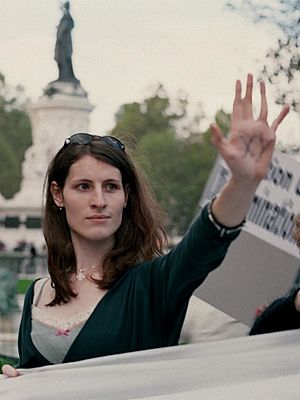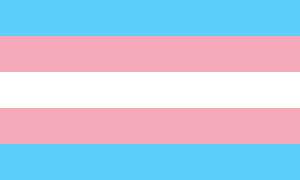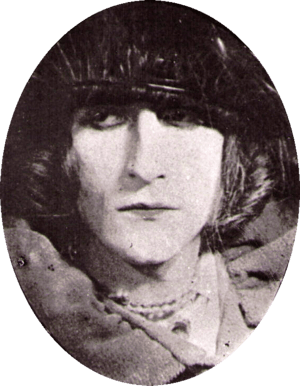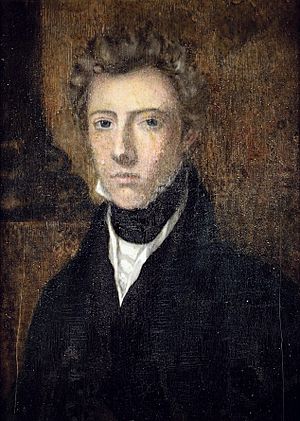Transgender facts for kids

Transgender people are individuals whose inner sense of being a man, woman, or something else is different from the gender they were thought to be at birth. This is known as a gender modality, meaning their gender identity does not match their assigned gender at birth.
Contents
Understanding Transgender Terms
The word "transgender" can describe many different people. People with unique ideas about their own gender often use this term. They might use various words to explain their gender. "Trans people" is a shorter way to say "transgender people."
Here are some important words and what they mean:
- Anatomical (biological) sex refers to whether someone was born with a male or female body.
- Cisgender is the opposite of transgender. It means a person whose gender identity matches the gender they were assigned at birth.
- Gender is how masculinity and femininity are seen and used by people. This is separate from anatomical sex.
- Gender expression is how a person acts or behaves. These actions can show others if they are seen as male or female.
- Gender identity is a person's inner feeling. It is their sense of whether they are a man, woman, something else, or neither (agender).
- The gender binary is the idea that a person must be either male or female. It suggests there are no other genders.
- Gender role is what society expects people to do based on their gender. For example, boys might be told not to play with dolls. Girls might be called a "tomboy" for climbing trees.
These definitions help us understand that how people look on the outside (their sex) is not always the same as how they feel inside (their gender). Some people do not fit into the gender binary idea.
It is best to use "transgender" as a descriptive word, like an adjective. Using it as a noun can sometimes be seen as disrespectful.
Different Types of Transgender People
The term "transgender" includes many different groups of people. Not all transgender people fit neatly into these groups. Here are some common terms:
- Transsexual – This is an older, more specific word. It was used in medical settings. Some people who want to change their bodies, for example, through surgery or hormones, prefer this term. Many people now prefer "transgender" over "transsexual." Some see "transsexual" as offensive because it used to describe identity as a disease. Doctors are advised to use "transsexual" only if a person is comfortable with it.
- AFAB – This means 'assigned female at birth.'
- AMAB – This means 'assigned male at birth.'
- Transgender Woman - This person was assigned male at birth (AMAB) but knows they are a woman. They are also called a 'trans woman.'
- Transgender Man - This person was assigned female at birth (AFAB) but knows they are a man. They are also called a 'trans man.'
- Genderqueer – This describes someone who does not believe in the gender binary. They may identify with many different gender terms. Genderqueer people might prefer to use the term "Non-Binary." This is often shortened to "enby."
- Transfeminine – Transfeminine is for any person, binary or non-binary, assigned male at birth. They have a mostly feminine gender identity or way of presenting themselves. Transmasculine is similar for someone assigned female at birth. They have a mostly masculine gender identity or presentation.
History of Transgender People
People like those we now call transgender have existed for thousands of years. They have been recorded in many different cultures. However, only in the last century have science and medicine found ways to help trans people change their bodies if they wish.
Some societies, both in the past and today, have accepted people who are different from the sex they were born with. For example, some Native American tribes accepted two-spirit people. In Tonga, a person born with a male body who acts and dresses in a female way is called a "fakaleiti."
In India, the "hijra" are people born physically male who live as women. They dress and socialize as female. Today, with modern medicine, many hijra choose to take hormones. Some also have medical procedures to change their bodies. Many still call themselves "hijra." Others now use "transsexuals" or "transgender women." The role of hijra in Indian society is varied and complex.
In Western society, there have always been people who chose to dress or act in ways not typical for their assigned sex. This is not always the same as being transgender. For example, actors who dressed in clothes of the opposite gender were popular in theatre in the late 19th century.
An example of a transgender person from history is James Barry. He was a military surgeon in the 19th century. It is now thought that Barry was born female but lived as a man his whole adult life. Barry's work helped thousands of lives by improving how wounds were treated. As a woman, he could not have gone to medical school or joined the army.
Another example from the 20th century is Jan Morris. She was a geographer, explorer, and journalist. She began life as James Morris. As "James," Morris married and had children. But she felt female and eventually became Jan Morris.
Challenges Faced by Transgender People
Transgender people are not accepted by everyone in all societies. They often face unfair treatment, discrimination, and even violence. Transgender people have worked hard to gain rights and protections in some places. In many areas, the fight for transgender rights is linked to the fight for gay and bisexual rights. These groups are sometimes called LGBT, which stands for lesbian, gay, bisexual, and transgender.
However, some transgender people do not want to be part of the LGB community. They may see themselves as heterosexual and feel they do not belong with gay or queer people. Also, some LGB people do not want to be part of the transgender community. This can be due to transphobia, which is a fear or dislike of transgender people. Still, gay and transgender people often face similar problems in society. So, many gay, lesbian, bisexual, and transgender people try to work together to solve these shared issues.
Mental Well-being
Some transgender people experience mental health challenges. Studies have shown that many transgender people have been diagnosed with depression or anxiety. Some also use antidepressants.
Transgender youth can feel sad or depressed. This might be because they are bullied by others. Or, they might feel unhappy as their body changes in ways they do not want. Some people say that high rates of depression mean transgender people are mentally ill.
However, other studies show that transgender people may have better mental health. This happens when they are able to live as their true gender.
Medical Support
Transgender people who want medical help to change their bodies face several issues. To make these changes, they need doctors who will support them. Sometimes, they cannot find doctors who will help. They might also not be able to afford the medicine or procedures. But the Declaration of Montreal states that such medical care should be provided. This care should be available through public health insurance.
Is Being Transgender a Medical Condition?
Some people used to believe that being transgender was a disease. It was sometimes called gender identity disorder. Many transgender people do not like being labeled with a disease. They feel this causes them to be treated poorly. Others believe the label is needed. This is because some governments and insurance companies will only pay for medical treatment if it is considered a disease. Also, in places without laws protecting transgender people, they might only be protected under laws for people with diseases or disabilities.
Doctors have different views on being transgender. Some see it as a birth difference that can be helped. Others do not think it is a medical condition at all. Since May 25th, 2019, the World Health Organization no longer sees being transgender as a disease or mental health problem. They have asked many countries to follow this view. One of the international human rights laws, the Yogyakarta Principles (Principle 18), disagrees with using any medical disease label.
Legal Challenges
Transgender people often face problems with laws about sex. To be seen and treated as the gender they know they are, transgender people usually need to change their first name. Some names can be used by both men and women. But transgender people with such a name might still want to change it. They also often want to change their official documents to show their correct gender. For example, a transgender woman might want her birth certificate or driving license to show her new female name and that she is female.
These changes can help protect transgender people from discrimination. For instance, transgender people often have trouble traveling. This is because they might look like one gender but have another on their papers. These changes can also be needed for transgender people to marry their partners. This is important in places where same-sex marriage is not allowed. These changes can even protect transgender people from various forms of violence. Some transgender people are only recognized when their documents show their true gender. Being revealed as transgender can put people in danger due to transphobia.
In many places, it is hard or impossible for transgender people to change their legal gender. This can be true even if they have had medical procedures. This goes against the Yogyakarta Principles. However, this is changing. The United Kingdom passed the Gender Recognition Act of 2004. This law allows people to have their gender change officially recognized without surgery. Once changed, they are legally their new gender. [1]
See also
In Spanish: Transgénero para niños





